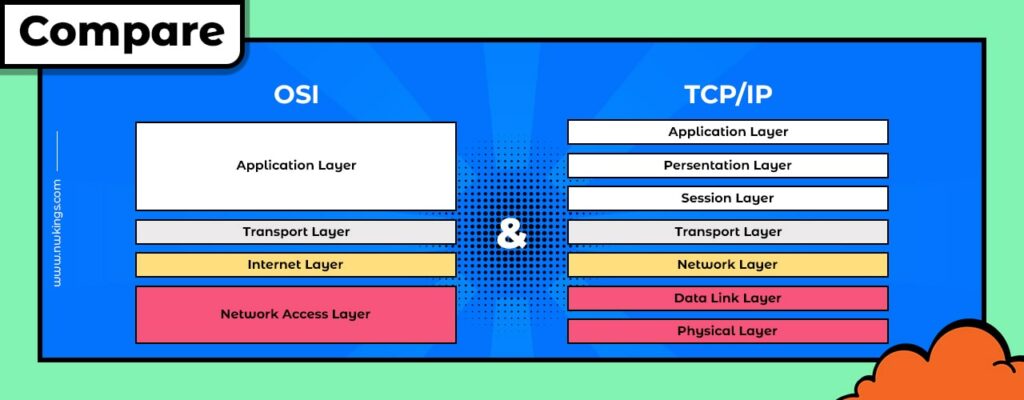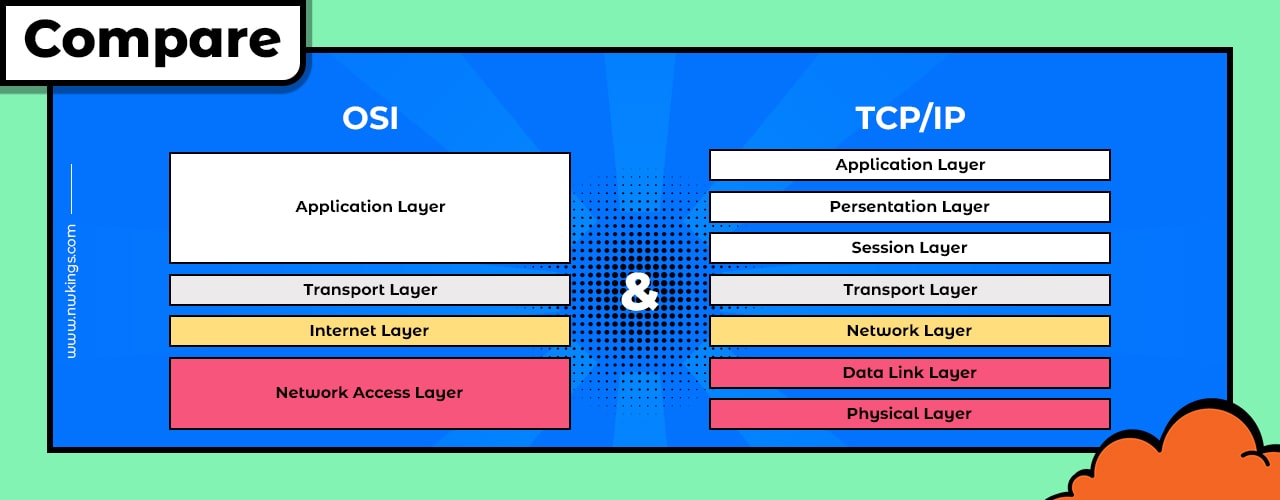
Are you looking for the difference between the OSI and TCP/IP models? Look no further! This blog will provide in-detailed information regarding the OSI and TCP/IP models in networking.
Therefore keep reading the blog till the end to familiarize yourself with the concepts.
What is OSI?
The OSI (Open Systems Interconnection) model is a conceptual framework describing layers used by computer systems to communicate over a network.
The OSI model illustrates computing functions into a versatile set of rules and provisions to support compatibility between different derivatives and software.
What are the layers of the OSI model?
There are seven layers of the TCP/IP model, namely-
- Application Layer
- Presentation Layer
- Session Layer
- Transport Layer
- Network Layer
- Data Link Layer
- Physical Layer
What is TCP/IP?
The TCP/IP (Transmission Control Protocol/Internet Protocol) model deals with the connection-orientated protocols determining that a device must establish a link before transmitting, acquiring or swapping the data or information.
Also, one must ensure the closure of the connection after exchanging the data and information in the TCP/IP model.
What are the layers of the TCP/IP model?
There are four layers of the TCP/IP model, namely-
- Process/Application Layer
- Host-to-Host/Transport Layer
- Internet Layer
- Network Access/Link Layer
Difference between OSI and TCP/IP.
The difference between OSI and TCP/IP models is as follows-
OSI | TCP/IP | |
Full Form | Open System Interconnection | Transmission Control Protocol |
Developer | ISO (International Standard Organization) has developed the OSI model. | ARPANET (Advanced Research Project Agency Network) has developed TCP/IP model. |
Definition | An autonomous measure and generic protocol used as a transmission gateway between the network and the end user refers to the OSI model. | A standard protocol leading to the development of the internet and acting as a transmission protocol establishing the connection among the hosts refers to TCP/IP model. |
Transport Layer | The transport layer assures the delivery of the packets in the OSI model. | The transport layer does not ensure the delivery of packets in the TCP/IP model. |
Approach | The OSI model works on a vertical approach. | The TCP/IP model works on a horizontal approach. |
Session/Presentation Layer | The session and presentation layers are separate in the OSI model. | The session and presentation layers are not distinguishable in the TCP/IP model. |
Model | OSI is a reference model via which various networks get built. | The TCP/IP is an executed model of OSI. |
Service | The network layer provides connection-oriented and connectionless services in the OSI model. | The network layer delivers solely connectionless service in the TCP/IP model. |
Protocols | The protocols are hidden and can get easily replaced in the OSI model. | The protocols can not get easily replaced in the TCP/IP model. |
Layering | A total of seven layers are there in the OSI model. | A total of four layers are there in the TCP/IP model. |
Dependency | It does not depend on protocols. | It depends on protocols. |
Usage | The usage of the OSI model is low. | The usage of the TCP/IP model is high. |
Standardization | The OSI model standardizes routers, motherboards, switches, and other hardware. | The TCP/IP model provides no standardization but a connection between computers. |
Distinction | OSI model distinctions between the services, protocols, and interface. | The TCP/IP model does not distinguish between the services, protocols, and interfaces. |
Reliability | OSI model is reliable. | TCP/IP model is reliable. |
Explain the similarities between OSI and TCP/IP models.
The similarities between the OSI and TCP/IP models are as follows-
- Both models are layered and build upon one another to provide end-to-end communication.
- Both models have physical layering for transmitting raw data over a physical medium.
- Both models have a network layer for routing data between networks.
- Both models have a transport layer to provide reliable or unreliable end-to-end delivery of data.
- Both models have an application layer to provide services to end users.
- Both models have a session layer to manage the maintenance and termination of sessions between applications.
- Both models have a presentation layer to handle the translation and encryption of data.
- Both models use protocols to define the rules and formats for communication between different layers and devices.
- Both models are open standards that get widely used in networking.
- Both models have limitations and weaknesses; network engineers often use their combination to design and troubleshoot complex networks.
Use of OSI and TCP/IP models
The OSI and TCP/IP models get used in the following ways-
- Web Browsing
While browsing the internet, your web browser sends a request to a server via multiple OSI layers. The request gets broken down into packets using TCP/IP, which then transmit across the internet to the server to create the requested webpage.
While sending an email, a client uses the Simple Mail Transfer Protocol (SMTP) to send the message, which uses the OSI model to process and route the message to its intended recipient.
- Video Conferencing
While in a video conference, the audio and video data gets broken down into packets using TCP/IP and sent across the network, forming the audio and video stream.
- Online Gaming
Online games use TCP/IP to transmit game data between players.
Wrapping Up!
The OSI and TCP/IP models are crucial networking components that help to transmit data and information between users and devices. They share the same architecture, have pre-defined standards, require a simplified troubleshooting procedure, and have identical ‘transport‘ and ‘network‘ layers functionality.
For more details, refer to our blogs on the OSI and TCP/IP model to learn the concepts better. Also, for any queries and questions, feel free to write in the box below.
Happy Learning!


